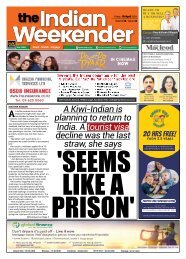The Indian Weekender, 26 March 2021
Weekly Kiwi-Indian publication printed and distributed free every Friday in Auckland, New Zealand
Weekly Kiwi-Indian publication printed and distributed free every Friday in Auckland, New Zealand
Create successful ePaper yourself
Turn your PDF publications into a flip-book with our unique Google optimized e-Paper software.
Editorial<br />
India central to the<br />
Indo-Pacific region<br />
<strong>The</strong> importance attached by the US to the Indo-Pacific, places India at an advantageous<br />
position, both in defence and economic sectors.<br />
While the world was combating the Covid pandemic, international leaders were also<br />
busy in realigning the world as per their country’s priorities and goals. One region, which has<br />
emerged on the top of this new realignment, is the region of the Indo-Pacific.<br />
<strong>The</strong> Indo-Pacific comprises the <strong>Indian</strong> Ocean, the western and central Pacific Ocean, and the<br />
seas connecting the two oceans around parts of Indonesia. <strong>The</strong> term “Indo-Pacific” gained usage in<br />
geopolitical discourse after 2011. It is also described as a substitute for “Quad” or the Quadrilateral<br />
Security Dialogue, an informal grouping of like-minded democracies in the region, comprising<br />
Australia, Japan, India, and the United States.<br />
Former Japan Prime Minister Shinzo Abe expanded on the spirit of the term in his speech to the<br />
<strong>Indian</strong> Parliament in August 2007 when he talked about the “Confluence of the <strong>Indian</strong> and Pacific<br />
Oceans” as “the dynamic coupling as seas of freedom and of prosperity” in the “broader Asia”.<br />
American push for the Quad<br />
Quad was first floated in 2004 to manage disaster relief after the Tsunami. Later, Dick Cheney<br />
tried to redefine it as a military club, to counter Chinese influence, but was abandoned in 2010 as<br />
India and Australia didn’t wanted to ruffle the Chinese feathers. <strong>The</strong> Trump administration revived<br />
the regional grouping in 2017, ostensibly to counter China in the region, particularly in the South<br />
China Sea, where the Chinese have continually challenged the Japanese and Americans.<br />
US under Trump wanted to shape the Quad into an Asian NATO, a point that has been raised<br />
and challenged by the Chinese again and again, as they see it as a potential defence deterrent in<br />
the region. <strong>The</strong> importance being attached to this by the original members, and the recent desire<br />
expressed by the British and French to join also underlines both its economic and defence utility.<br />
Though the Biden administration wants to position it as an American outreach on trade, immigration,<br />
public health, climate change, yet its security aspect can’t be overlooked.<br />
To give a boost to the alliance, the leaders of the Quad met on <strong>March</strong> 12, <strong>2021</strong>through a virtual<br />
summit. <strong>The</strong> summit and the joint statement issued highlights the evolution of the grouping and its<br />
agenda made clearer and resolve by the member states to sustain the momentum.<br />
At a White House press conference following the summit, the U.S. National Security Advisor<br />
Jake Sullivan noted that each of the four leaders present had described the meeting as “historic.”<br />
Quad talks were elevated to the ministerial level in 2019 with foreign ministers from all four<br />
countries holding a meeting on the margins of the United Nations General Assembly session in<br />
New York in September that year. Since then, Quad foreign ministers have met twice: in-person in<br />
Tokyo in October last year, and virtually last month.<br />
President Biden has zealously endorsed the “free and open Indo-Pacific” jargon favoured by his<br />
predecessor, contrary to apprehensions that he would seek to adopt a softer line toward China and<br />
that the Indo-Pacific paradigm would not be so significant for the new administration.<br />
However, the reality is that the Quad, in essential sense is not a formal alliance, yet. <strong>The</strong> recent<br />
summit concentrated primarily on urgent global catastrophes comprising coronavirus and the<br />
climate emergency and tried not to ruffle feathers or cause undue apprehensions in the regional<br />
countries, particularly ASEAN member states. A joint statement after the assembly noted that the<br />
four nations would collaborate to increase Covid vaccine production, in which India would be<br />
helped financially by other members to boost its vaccine production base. But differences remained<br />
among the member states on how to handle China.<br />
India’s future in the Quad<br />
<strong>The</strong> moot question is whether Quad in essential sense would be transformed into a real regional<br />
alliance or will it continue to serve some countries only, to use it as and when required as per their<br />
necessity. Though one country, which seems poised to gain most out of Quad is India. Due to its<br />
vast market potential and also as a counter to China in the region, most western powers attach great<br />
importance to it in the region. <strong>Indian</strong> leaders also realise this besides the fact that to transform into a<br />
regional power it has to pursue a geopolitical strategy, which maximises its economic interests and<br />
security. <strong>The</strong> <strong>Indian</strong> Prime Minister has spelled out the <strong>Indian</strong> vision of Indo-Pacific as an enabler<br />
for “a common pursuit of progress and prosperity... not directed against any country... (albeit based<br />
on) our principled commitment to rule of law.”<br />
India’s role at the Quad seems central to the Biden administration’s plans for the region and the<br />
quest to counter China. US initiatives so far suggests the Biden administration is serious about its<br />
stated intention to counter China through alliances, based on shared values, and that it sees the Quad<br />
and India as central to that. At the same time the US seems ready to moderate India’s feeling of<br />
insecurity in regard to be part of a binding alliance along with its ambition to emerge as a dominant<br />
regional player, while downplaying China.<br />
It seems that the US wants to promote bilateral ties by bolstering India at the Quad, and also<br />
focussing on more areas of cooperation, which were ignored during the Trump regime. <strong>The</strong> recent<br />
visit of the US Defence Secretary Lloyd Austin to India demonstrates both these aspects.<br />
With Tony Blinken at the State Department and Jake Sullivan at the National Security Council,<br />
as well as Mr Biden himself, the current US administration possesses more experience of dealing<br />
with India than any of its predecessors. It also highlights its resolve to make Indo-US relations as<br />
central to its plans. With China as a common denominator, the relationship holds more chances of<br />
being robust and fruitful for both. And the key role, which the US wants India to play at the Quad, is<br />
more apparent now. It may also open the doors for increased bilateral cooperation and sale of more<br />
American military hardware to India besides economic benefits.<br />
Thought of the week<br />
"Concentrate all your thoughts upon the work<br />
in hand. <strong>The</strong> sun's rays do not burn until brought<br />
to a focus." – Alexander Graham Bell<br />
<strong>26</strong> <strong>March</strong> – 01 April <strong>2021</strong><br />
Fri Sat Sun Mon Tues Wed Thu<br />
On-and-off<br />
rain and<br />
drizzle<br />
22°<br />
14°<br />
Partly<br />
sunny<br />
24°<br />
13°<br />
25°<br />
14°<br />
<strong>Indian</strong> <strong>Weekender</strong> : Volume 13 Issue 02<br />
Publisher: Kiwi Media Publishing Limited<br />
Content Editor: Sandeep Singh | sandeep@indianweekender.co.nz<br />
Chief Reporter: Rizwan Mohammad | rizwan@indianweekender.co.nz<br />
Chief Technical Officer: Rohan deSouza | rohan@indianweekender.co.nz<br />
Sr Graphics and Layout Designer: Mahesh Kumar | mahesh@indianweekender.co.nz<br />
Graphic Designer: Yashmin Chand | design@indianweekender.co.nz<br />
Accounts and Admin.: 09-2173623 | accounts@indianweekender.co.nz<br />
Media Sales Manager.: Leena Pal: 021 952 216 | leena@indianweekender.co.nz<br />
Sales and Distribution: 021 952218 | sales@indianweekender.co.nz<br />
Editor at Large: Dev Nadkarni | dev@indianweekender.co.nz<br />
Views expressed in the publication are not necessarily of the publisher and the publisher<br />
is not responsible for advertisers’ claims as appearing in the publication<br />
Views expressed in the articles are solely of the authors and do not in any way represent<br />
the views of the team at the <strong>Indian</strong> <strong>Weekender</strong><br />
Kiwi Media Publishing Limited - 133A, Level 1, Onehunga Mall, Onehunga, Auckland.<br />
Printed at Horton Media, Auckland<br />
Parlty<br />
sunny<br />
Clouds and<br />
sun<br />
24°<br />
15°<br />
A touch o<br />
dafr<br />
This week in New Zealand’s history<br />
28 <strong>March</strong> 1923<br />
Forest and Bird founded<br />
25°<br />
25°<br />
Copyright 2020. Kiwi Media Publishing Limited. All Rights Reserved.<br />
Sunshine<br />
and pactcy<br />
clouds<br />
<strong>26</strong>°<br />
15°<br />
A few<br />
morning<br />
showers<br />
<strong>26</strong>°<br />
17°<br />
<strong>The</strong> New Zealand Native Bird Protection Society was formed at a meeting in Wellington<br />
called by a local conservation advocate, Captain Ernest ‘Val’ Sanderson.<br />
28 <strong>March</strong> 1955<br />
NZ cricketers skittled for <strong>26</strong><br />
In recent years most test matches between New Zealand and England have been keenly<br />
contested. This was not the case in 1955.<br />
28 <strong>March</strong> 1983<br />
Signing of CER agreement strengthens trans-Tasman<br />
trade ties<br />
<strong>The</strong> Australia–New Zealand Closer Economic Relations Trade Agreement, better known as<br />
CER, was New Zealand’s first comprehensive bilateral trade agreement, and one of the first<br />
such agreements in the world.<br />
29 <strong>March</strong> 1901<br />
Skippers Bridge opened<br />
At 96 m long and 91 m above the river, the Skippers suspension bridge over the Shotover<br />
River near Queenstown in Central Otago is one of the highest and most spectacular in<br />
New Zealand.<br />
1 April 1773<br />
First beer brewed in New Zealand<br />
In an attempt to concoct a preventative against scurvy, Captain James Cook brewed a batch of<br />
beer on Resolution Island in Dusky Sound, using rimu branches and leaves.<br />
1 April 1965<br />
TEAL becomes Air New Zealand<br />
New Zealand’s international airline, Tasman Empire Airways Limited (TEAL), was<br />
renamed Air New Zealand Limited.<br />
1 April 1978<br />
<strong>The</strong>rmal insulation required in NZ homes<br />
Māori houses (whare) were made of natural materials that had good thermal performance<br />
(such as raupō reeds) or kept out the wind (such as earth). European-style timber frame<br />
construction was less efficient at retaining heat, but it was not until 1978 that the level of thermal<br />
insulation required in new houses was specified by law.


















